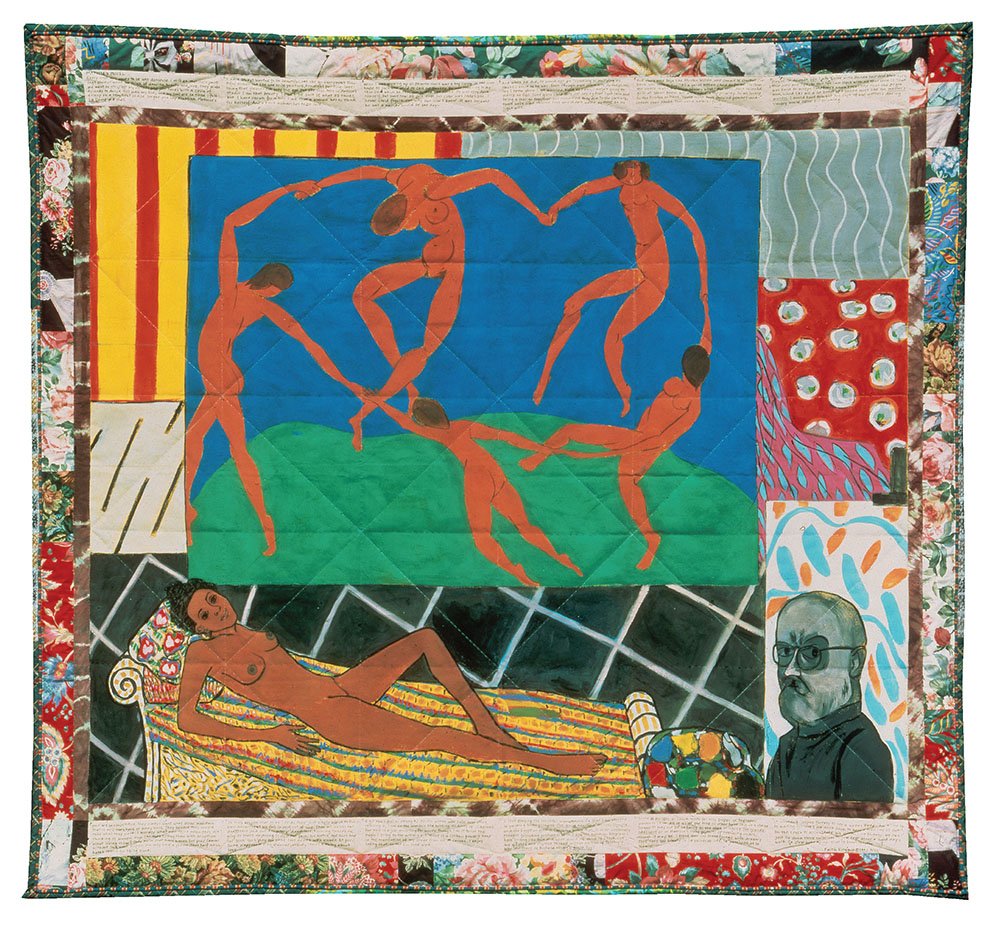
On the cover: “Matisse’s Model (The French Collection, Part1: #5), 1991 by Faith Ringgold
Matisse’s Model (The French Collection, Part 1: #5), 1991
By Faith Ringgold
Acrylic on canvas, printed and tie-dyed pieced fabric, and ink
Courtesy of the Baltimore Museum of Art. Frederick R. Weisman Contemporary Art Acquisitions Endowment.
To take in the protean career of Faith Ringgold⎯as I did recently at the New Museum’s landmark retrospective Faith Ringgold: American People, which ripples across five decades and many media⎯ is to feel that no one form or surface can contain what she has to say. Ringgold, née Jones, grew up in the 1930s surrounded by the luminaries of the Harlem Renaissance, including Langston Hughes and Duke Ellington; jazz great Sonny Rollins was a childhood friend. While her earliest paintings were inspired by French Impressionism (she first traveled to Paris in 1961), the Black Arts Movement and the writing of James Baldwin infused her canvasses with political urgency. By the late 1960s, her American People Series and Black Light Series engaged with civil rights and racial violence while playing with pop art and other contemporary idioms and working toward a Black Power theory of color—in the Black Light Series, she excluded white pigment, discovering a new language of tone and contrast.
Ringgold’s canvasses, such as The Flag Is Bleeding (1967) and Flag for the Moon: Die Nigger (1969), recall Jasper Johns’s collapsing of abstraction and representation. These paintings also participated in a late-sixties trend of incorporating the American flag into politically charged artworks, and in 1970, Ringgold was arrested along with two other artists for flag desecration at a protest exhibition called The People’s Flag Show. A prolific performance artist and activist, she also helped to stage proto-Guerrilla Girls-type protests advocating inclusivity in museums.
In the 1970s, Ringgold stopped painting on stretched canvas—a move both practical and political. According to Massimiliano Gioni, who curated the New Museum’s exhibition, Ringgold wanted to be able to transport works by herself, rather than relying on her husband to move large canvasses. The turn to textiles was an embrace not only of traditionally feminine “crafts” (Ringgold became active in the women’s movement in 1970) but of non-Western forms. In her series Slave Rape (1972), she combined oil painting and quilting techniques into “tankas” inspired by the Tibetan Buddhist paintings on cotton and silk that she first encountered in the Rijksmuseum in Amsterdam.
The form Ringgold developed in subsequent decades combined painting, quilting, and text into what she called “story quilts,” narrative pieces on topics from Harlem to weight loss to friendship, and some of the stories made their way from quilt to page as Ringgold adapted them into a series of children’s books, including the award-winning Tar Beach (1991).
Despite Ringgold’s subversion of western forms and spaces, European painters and museums remained formative sources of inspiration, and so she found ways to imagine Black beauty and experience into that history. Perhaps her most ambitious narrative project is The French Collection, a series of twelve story quilts which follow protagonist Willia Marie Simone, a fictional Black expatriate in 1920s Paris. In the series, Willia hobnobs with Picasso and Gertrude Stein and writes postcards home to her aunt Melissa. In Matisse’s Model, she reclines for the painter in an Olympia-like pose in front of La Danse, which evokes for Willia “dancing, beauty and love,” which “make me want to strip off my clothes and join hands.” She goes on:
I have always wanted to be beautiful, not like an anonymous beautiful woman but like une belle peinture, beautiful painting. Something that pleases not only the eye but the soul. Here in Matisse’s studio I am that beauty. I can’t be sure of what HE thinks, but I have known for a long time that a woman has to think for herself. And a black woman has to be sure.

